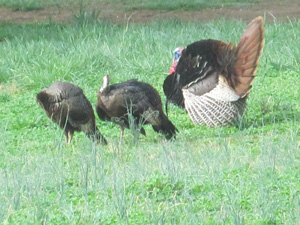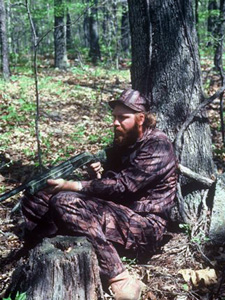
 The woods seemed to rattle when the tom bellowed back at me from his roost, barely 100 yards away. After that one response to my soft tree call on the diaphragm, I stopped calling. With a whoosh of wings he was down on the ground and immediately double-gobbled.
The woods seemed to rattle when the tom bellowed back at me from his roost, barely 100 yards away. After that one response to my soft tree call on the diaphragm, I stopped calling. With a whoosh of wings he was down on the ground and immediately double-gobbled.
Yelping softly on a box call, I heard the turkey thunder back loudly again, then froze in the ready position. Soon I heard the muted sound of the bird drumming. Seconds later a gorgeous spread fan appeared, framing the bird's bright red and powder-blue head.
When the gobbler edged behind a white oak, I shifted my barrel just a few inches to the right. As he stepped out from behind the tree at 30 yards, I squeezed off on the head and neck. The hunt was finished before the sun crested the eastern horizon. The bird had long sharp spurs and a 10-inch beard.
Elements for Success
What made that hunt a success? Certainly lots of things were involved. They're the elements most of us focus on when we plan and execute hunts for spring toms. A good hunting area was certainly one component. Proper camouflage helped, as did using the right gun and load. Scouting before the opener also helped. And knowing how to use several different calls was an important part of that successful hunt.
But more important than any other factor was something far too many hunters pay little attention to setting up in just the right location and sitting in the right position.
For starters, no obstacles were present between the tom and my calling position. I was in an area that wasn't too thick and congested. And it was in a spot where I'd seen gobblers strutting before, making it a traditional mating location.
I was leaning back against an oak tree wide enough to cover my outline. My knees were up so I could rest the shotgun barrel across them and wouldn't get tired and move at an inopportune moment. And I had cleared rocks out before sitting down so I wouldn't squirm and fidget. Lastly, the gun was up and aimed so I only had to make a slight movement to be in final aiming position. All of these are elements of the crucial aspect of setting up for a successful spring turkey hunt.
Position is Everything
 |
| Sit against a wide tree to help eliminate your human outline so not to spook the turkeys. |
Jim Clay, a champion caller and founder of Perfection Calls, said, "Give me a poor position and setup and I'll call in 5-10 percent of gobblers I hear. Give me a perfect setup and I'll call in 50-75 percent of them."
There's a lot we can't control in turkey hunting such as weather, stage of the breeding process, presence of hens, other hunters in the woods, etc. But setting up and sitting properly before attempting to call in a bird is one thing we can.
Before the hunt, locate positive environments for the gobbler such as dry strips between boggy areas, saddles that make crossing ridges easy, natural meadows where birds can display, water holes, and feeding sites such as fields.
"You want to make it easy for the bird to come to you by positioning in these areas gobblers prefer to use," says Mississippi call maker Will Primos.
Once you hear a bird call, remember where these positive elements of the habitat are and where negative ones are, such as steep ravines, brushy areas and obstructions. Move to the best spot where you suspect the gobbler will likely head and avoid the negative areas.
Move in Close
"Get as close as you think you can without him seeing you," says Rob Keck, former Chief Executive Officer of the National Wild Turkey Federation. "In some places that may be 50 yards, in other locations it may be 300 yards. It varies with the terrain, thickness of vegetation, foliage stage and other factors, and it varies as the season progresses."
Getting close makes it less likely a real hen will call the gobbler in first and it allows you to make sure there are no obstacles between you and the bird.
World Champion caller Kelly Cooper has another piece of advice: "Sit where you can't see the gobbler until you can shoot him, if possible. That way you can't mess up by moving and he can't become alarmed because he can't see the hen he hears calling. He knows he can't because of the rise in terrain, slope or whatever."
Importance of Sunlight
Also consider sun angle and shade. "I avoid sitting in a spot where a bird has to approach looking directly into low angle sunlight," Jim Clay says. "He may swing around and walk in from the side or behind to avoid coming into the harsh light."
"Give him the advantage," adds Cooper. "He knows he can't see as well looking into the sun, so you should set up so you look into it if necessary."
Where to Sit
Never sit in thick cover. You won't be able to move your gun easily and the bird won't want to come into it because it's afraid of foxes and coyotes.
The best solution is to sit back against a wide tree, preferably as broad across as your body. The back support will make it easier to wait out a tom and the trunk will also break up your outline. Of course if you're hunting in the southwest and no trees are around, you may need to set up against a large rock or cedar bush to hide your human form.
How to Sit
 |
| Use your knees to balance your rifle to make a steady shot. |
How you position your body and gun is extremely important for a successful turkey hunt. Says Rob Keck, "People who have done everything else right up to this point often fail in this final area. They don't know how to sit down and position themselves to complete the hunt successfully.
"Even if a turkey is bearing down close on me, I take the extra time to clear a spot where I'm going to put my butt down," he says. "You never know when the turkey might hang up. You might have to sit there for hours. Try to get the sticks and stones and sharp objects out. Then drop down the seat on your turkey vest or jacket. This is an essential piece of equipment that will cushion your butt and help you remain motionless. Comfort is important. Sometimes it isn't played up enough."
Gun Position
"If you're a right-handed shooter, sit so your left shoulder is facing the bird's location," says Keck. "This way you'll have the best shot possibility if the turkey swings in from either side. It's easier to shoot the gun that way. Sit with your knees propped up. The fore-end of the gun then rests on the knees so you don't have to hold up the weight with your arms.
Always keep the gun pointed in the direction of the turkey or where you think he's going to come from. Then, as he makes his approach, get further down into the gun. When he gets say 70 or 80 yards out, put the butt of the gun up to your shoulder, but still leave the fore-end of the gun resting on the knee. You can hold it there for quite a while. Free-hand is totally out. So many people want to try to hold their gun up there, and the next thing you know, they're cutting figure eights and spooking the bird or missing the shot.
Making the final move to come to full aim from this position must be done carefully. Don't focus on the bird's beard or try to see his spurs. Just look at his eyeballs. As long as you can see his eye you can determine when you can move safely without being seen. When the eyeballs go behind a tree, make your move to get the gun exactly on him."
Final repositioning of the gun should be quick. It may not take the bird more than a second or two to appear from behind the tree, where it can see you. Then you should have the sight or scope on its head and neck and be ready to press the trigger smoothly when the bird is at 35 yards or less.
As you claim your prize and admire the gobbler's tail feathers, spurs and beard, taking the extra time to choose just the right setup and sit in just the right position will seem well worth the effort.
Camouflage
All of these setup efforts will be useless if you do not wear camouflage clothing from head to foot. Choose patterns that match the foliage stage where you are hunting and the local vegetation. Anything from dark grays and browns to tan and green may be required. The best bet is to have several sets and wear the one that's appropriate for the time and place you are hunting.
- 7363 views

